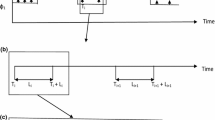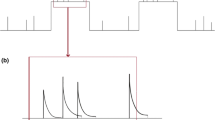Abstract
Rainfall in time at any ground location can be described by the rain intensity distribution over the subtrajectories which are drawn by the ground location point on the radar-detected incremental rain fields (IRFs) that pass over this location. Based on this conceptualization, this study develops a stochastic description of the arrivals of IRF subtrajectories (SIRFs) onto any given set of ground locations over a geographical region. The arrivals of SIRFs is described by a multivariate doubly stochastic Poisson process, excited by the time-space arrival process of IRFs onto the designated geographical region. The arrival process of IRFs is described by a 3-level time-space nonhomogeneous Poisson cluster model. At the primary level of this model are the arrivals of synoptic cyclonic systems; at the secondary level are the arrivals of large mesoscale rain areas (LMSAs) and at the tertiary level are the arrivals of IRFs onto the designated geographical region, all detected by the weather radar. The models are substantiated both by the graphical analysis of rain fields, as detected on a radar scope, and by the statistical analysis of the arrivals data at all of the four levels at three different ground locations over a rectangular geographical region in Northern Kentucky. It is pointed out that a doubly stochastic Poisson process is basically a Poisson cluster process. Hence, the final process of SIRF arrivals onto any ground location may be interpreted as a 4-level Poisson cluster process. Finally, heavy tails in the sample covariance density functions of the IRF and SIRF arrivals are detected. This study shows that the appropriate incorporation of clustering at all observable distinct scales of the rain fields models the heavy tail behavior of the covariance density adequately.
Similar content being viewed by others
References
Daley, D.J.; Vere-Jones, D. 1972: A summary of the theory of point processes. In: Lewis, P.A.W. (ed.) Stochastic point processes, Wiley, N.Y.
Fisher, L. 1972: A survey of the mathematical theory of multidimensional point processes. In: Lewis, P.A.W. (ed.) Stochastic point processes, Wiley N.Y.
Hawkes, A.G. 1971: Spectra of some self-exciting and mutually exciting point processes. Biometrika 58 (1), 83–90
Kavvas, M.L.; Delleur, J.W. 1984: A statistical analysis of the daily stream flow hydrograph. J. Hydrol. 71, 253–275
Kavvas, M.L.; Herd, K.R. 1985: A radar-based stochastic model for short-time-increment rainfall. Water Res. 21 (9), 1437–1455
Lovejoy, S.; Mandelbrot, B. 1985: Fractal properties of rain, and a fractal model. Tellus 37A, 209–232
Moyal, J.E. 1962: The general theory of stochastic population processes. Acta Math. 108, 1–31
Myrup, L. 1985: Atmospheric dynamics, a syllabus for atmospheric Science 121B, University of California, Davis, 98 pp
Author information
Authors and Affiliations
Rights and permissions
About this article
Cite this article
Kavvas, M.L., Chen, Z. A radar-based stochastic model for the time-space arrivals of the rain fields onto a geographical region. Stochastic Hydrol Hydraul 3, 261–280 (1989). https://doi.org/10.1007/BF01543460
Accepted:
Issue Date:
DOI: https://doi.org/10.1007/BF01543460




